
Original Link: https://www.anandtech.com/show/4288/toshiba-satellite-m645-steady-progress
Toshiba Satellite M645: The Steady March of Progress
by Dustin Sklavos on April 29, 2011 12:50 AM ESTIntroducing the Toshiba Satellite M645
Toshiba has spent the last half a decade carving out an interesting niche as a notebook manufacturer, with many consumer-grade notebooks that are ostensibly budget offerings but often feature a markedly different look and feel from the kinds of laptops vendors like Dell, HP, and Acer produce to serve this market segment. Oftentimes they can feel stylistically behind the curve, but every so often they produce a big winner as they did with their Portege R700 series.
Now, a trickle-down of style couples with modern hardware in a respectable new entrant in their venerable Satellite line: the M645. Our review unit features a shiny new Sandy Bridge mobile dual-core processor along with a healthy amount of memory, an Optimus-enabled NVIDIA GeForce 500M series GPU, and a Blu-ray combo drive, all in a reasonable 14-inch chassis. But it threatens to set you back a grand: is it worth it?
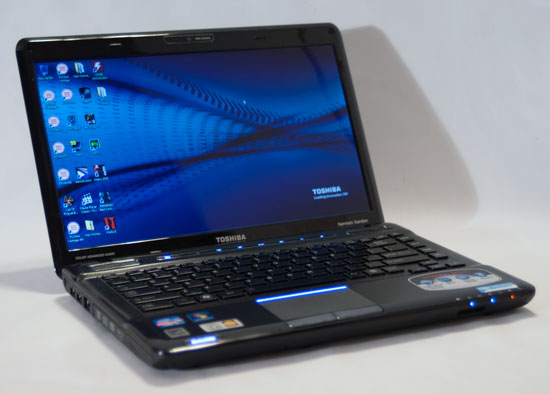
The elegantly titled M645-S4118X we have on hand for review is the most expensive unit in Toshiba's M640 line, and as you'll see from the specifications, it largely earns that. This is as decked out as Toshiba's 14-inch consumer notebooks get, featuring a lot of power and flexibility. Here's what you get:
| Toshiba M645-S4118X Specifications | |
| Processor |
Intel Core i5-2410M (2x2.3GHz + HTT, 2.9GHz Turbo, 32nm, 3MB L3, 35W) |
| Chipset | Intel HM65 |
| Memory | 4GB DDR3-1333 and 2GB DDR3-1333 (6GB Total, Max 2x4GB) |
| Graphics |
NVIDIA GeForce GT 525M 1GB DDR3 (Optimus) (96 CUDA cores, 475MHz/950MHz/1.8GHz core/shaders/memory) Intel HD 3000 (12 EUs, 650-1200MHz core) |
| Display |
14-inch LED Glossy 16:9 1366x768 (Chi Mei N140B6-L02 Panel) |
| Hard Drive(s) | Toshiba 640GB 5400RPM SATA 3Gbps Hard Disk |
| Optical Drive | BD-ROM/DVD+-RW Combo Drive w/ Labelflash |
| Networking |
Realtek PCIe FE 10/100 Ethernet Atheros AR9002WB-1NG 802.11n Wireless Bluetooth 3.0+EDR |
| Audio |
Realtek ALC269 HD audio Stereo speakers Headphone and microphone jacks |
| Battery | 6-Cell, 10.8V, 48Wh battery |
| Front Side |
Indicator lights SD/MS/MMC reader |
| Left Side |
Kensington lock 2x USB 2.0 Ethernet jack Optical drive |
| Right Side |
Headphone jack Microphone jack HDMI USB 3.0 VGA Exhaust vent AC adaptor jack |
| Back Side | - |
| Operating System | Windows 7 Home Premium 64-bit |
| Dimensions | 13.3" x 9.0" x 1.12"-1.39" (WxDxH) |
| Weight | 5.4 lbs |
| Extras |
Webcam Flash reader (MMC, SD/Mini SD, MS/Duo/Pro/Pro Duo) Blu-ray drive Backlit keyboard USB 3.0 Bluetooth |
| Warranty | 1-year limited warranty |
| Pricing |
MSRP at $1,099 Available online at $999 |
Starting from the top we have one of Intel's midrange Sandy Bridge mobile processors, the Core i5-2410M. Like its kin it features 3MB of L3 cache along with Hyper-Threading, and depending on thermals and workload it can turbo up to 2.6GHz on two cores or 2.9GHz on one core. Its only real weak point is that its HD 3000 GPU tops out at 1200MHz instead of the 1300/1350MHz you get on some of the faster models, but given our next major component that shouldn't be a huge issue.
The M645 benefits greatly from the inclusion of the NVIDIA GeForce GT 525M with 1GB of DDR3 running at 900MHz (1.8GHz effective) and Optimus technology to maximize battery life while allowing the end user to enjoy both a decent mobile gaming GPU as well as Intel's Quick Sync hardware video encoder. Unfortunately, this is a point where the unit also falters: Toshiba runs the GT 525M at clocks well below spec. NVIDIA specifies the 525M to run the core at 600MHz (and thus the 96 CUDA cores at 1.2GHz), but Toshiba has substantially reduced its core clock to just 475MHz (reducing the CUDA cores to a paltry 950MHz). The cut is a brutal one that you'll see reduces performance below even a GeForce GT 420M.
Fortunately, all is not lost. Toshiba includes a generous 6GB of DDR3-1333, and while the 5400RPM spindle speed on the hard drive is slow, at least the 640GB of storage is copious. Better still, Toshiba also includes both a Blu-ray drive and a USB 3.0 port. The backlit keyboard is also a welcome touch, but the inexplicable lack of gigabit ethernet connectivity is troubling, and the mediocre 48Wh 6-cell battery is unfortunate.
In terms of the internal hardware, we really wind up with mixed feelings all around as Toshiba has been generous in some places while frustratingly stingy in others. At the price Toshiba is asking, some of these trade-offs just shouldn't have been made.
Finally, a Little Less Gloss
There have been a couple of manufacturers that historically have hit my pet peeves when it comes to notebook design. Clevo and Acer both have dire keyboards that they frustratingly cling to even in the face of the kind of progress Dell and HP tend to get swept up in, and Toshiba seemed to have invested whole hog in glossy plastic for the longest time. Mercifully, while Clevo and Acer still have those same awful keyboards, Toshiba got the hint from the success of the Portege R700, and has proven themselves a little more agile and willing to change.
The end result is an aesthetic that feels a little clunky, but is at least a major step in the right direction. While smooth glossy plastic is still present (particularly in my most hated of places, the screen bezel), it's used largely more as an accent than a style on the M645. The lid, palmrests, and area around the keyboard are all black and feature a pleasant patterning that's comfortable to use. In the most technical sense this is still glossy plastic, but it's heavily textured in such a way that's much more pleasing—it's the same look as seen on the A660-series laptops we've reviewed in the past, only in a smaller chassis.
In keeping with the times and proving that white is the new blue, Toshiba uses white LEDs for nearly all illumination on the M645, including indicators and the keyboard backlighting, with orange as a secondary color for the indicator LEDs on the front rim of the notebook. I can't complain; there are reasons why blue LEDs caught on the way they did, and the white ones are no different. They're just pleasing to look at.
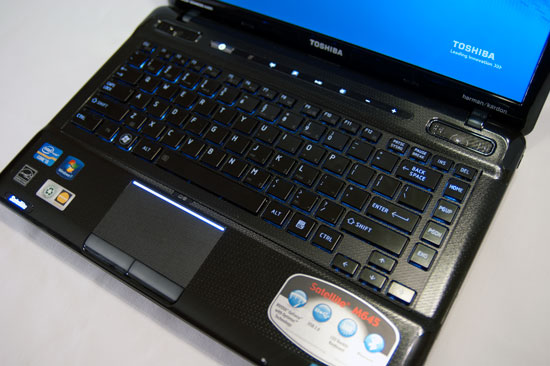
As for the keyboard itself, the chiclet-style seems to be in vogue right now, and that's fine. Toshiba has a solid layout that's easy to use, and the flex that's present is fairly minimal. I'm disappointed that glossy plastic is used for the keys as it produces an odd texture when you slide your fingers across them, but at this point I just appreciate the progress compared to the big, flat, borderline-slick keys that permeated last generation Toshiba notebooks. At the moment the only manufacturer that seems to consistently nail keyboard designs to near-flawlessness is Lenovo; HP's double-high left and right arrow keys on their modern keyboards are downright bizarre, and Dell seems to still be trying to figure out exactly what kind of key surfaces to use. It's strange the kind of alchemy that continues to occur when it comes to keyboard design; the one part of the notebook that should be seeing the least change over the decades continues to see reinvention. But I digress; Toshiba's keyboard on the M645 is a major improvement on its predecessors, and a change in materials would finish the job.
Touchpads are also tricky things, but Toshiba wisely gets the texture right. These seem to be a matter of taste, but I've found two dedicated buttons along with a mildly textured surface is oftentimes the right call for me, and I had no trouble using the touchpad on the M645. The dedicated touchpad toggle is a constant and appreciated inclusion.
Unfortunately there are still a couple of places where I feel like Toshiba could stand some improvement in their overall designs. The M645 feels curiously bulbous compared to notebooks from competitors, machines that have generally gotten progressively sleeker and eschewed these rounded corners. That's a minor complaint; my major gripe still lies with the use of glossy plastic. It just doesn't belong on the bezel, but at least it's gradually phasing out of the market. The capacitive control strip above the keyboard also feels passe, and most people I know would rather use actual physical buttons than touch-based controls.
Finally, on the feature side, Toshiba made too many perplexing trades here. I appreciate the inclusion of a USB 3.0 port and a Blu-ray drive, and dedicated graphics in a 14-inch form factor are still all too rare in the mainstream notebook market, but why no gigabit ethernet? I'm also sad to see Samsung's hard drive division get sold off to Seagate while Toshiba's continues to plug away at producing mediocre notebook drives. Maybe it's a cost-saving measure, who can say? However, my experience with Toshiba drives is that they've always been the slowest of the slow (alongside Fujitsu). 640GB of space is generous, but most users would probably be willing to sacrifice some of that capacity for at least a higher spindle speed. Notebooks in the price bracket Toshiba targets with the M645 almost always include 7200RPM drives as a matter of course, making the dog slow 5400RPM drive in this notebook an outlier.
Mainstream Performance
While Jarred has already gotten his mitts on a couple of dual-core Sandy Bridge notebooks, this is my first experience with the new architecture in this form. From the numbers I pulled testing the Toshiba M645, it looks like the old, perennially-underpowered quad-core i7-720QM workhorse may finally be put out to pasture. It's still somewhat faster than the 2410M in multi-threaded workloads, but it loses everywhere else.
We've highlighted three other systems for comparison in this round. In black we have the Dell XPS 15 L502x, sporting a quad-core i7-2630QM and GT 540M graphics. Last year's XPS 15 L501x with i5-460M and GT 420M is in red, and finally we have the i5-2520M with HD 3000 showing what you can get from dual-core Sandy Bridge without a discrete GPU.
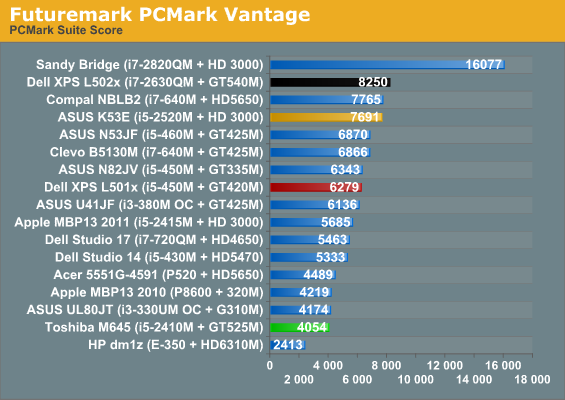
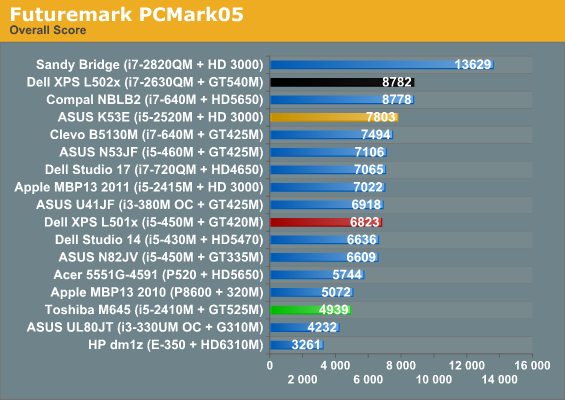
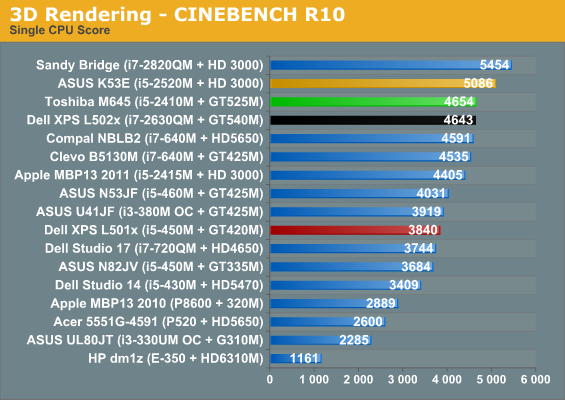
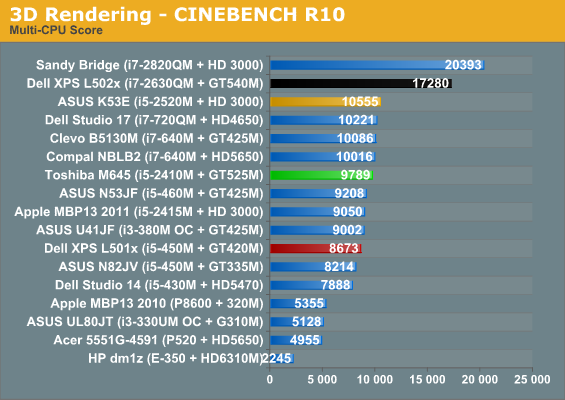
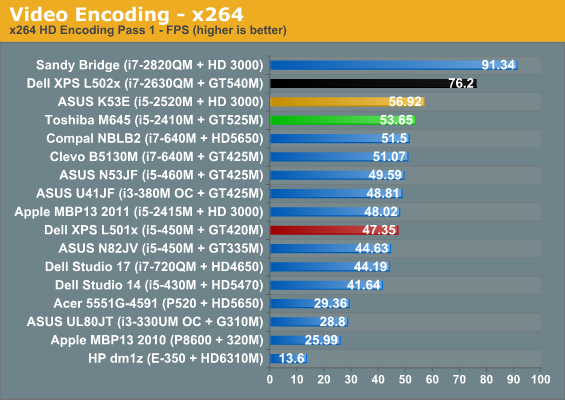
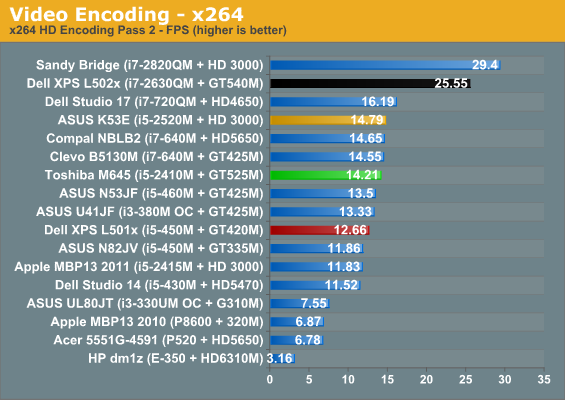
PCMark is unkind to the M645, but it tends to skew heavily towards faster storage subsystems and the 5400RPM Toshiba hard drive is among the slowest. When we get to more CPU-limited workloads like Cinebench and x264 encoding, the i5-2410M is allowed to stretch its legs and the M645 surges forward to near the top of the heap, producing performance virtually on par with last generation's top end mobile dual-core chip. The i7-640M threatened the i7-720QM with early obsolescence, and the middle-of-the-road i5-2410M only helps make good on that threat. Such is progress.
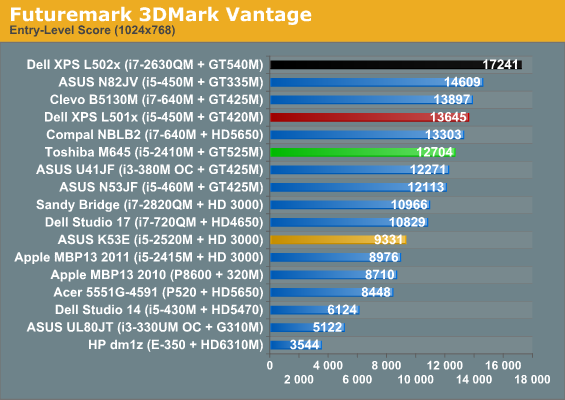
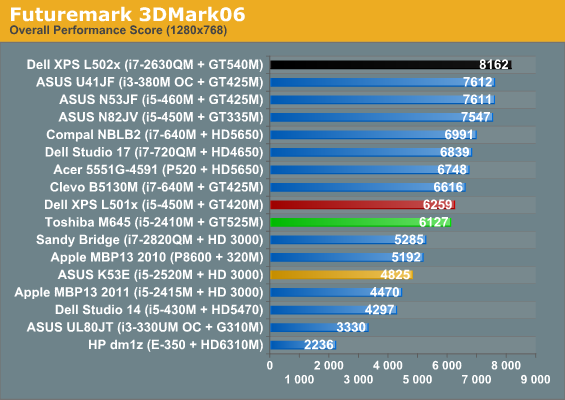
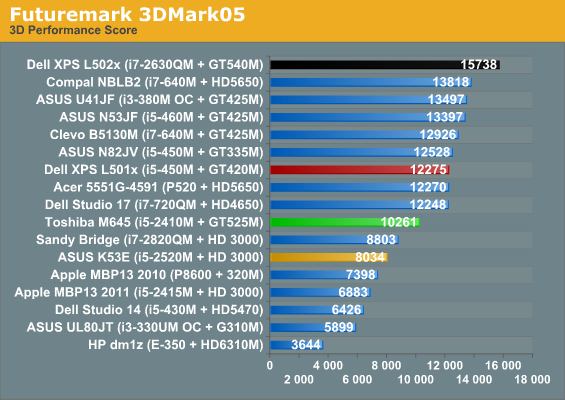
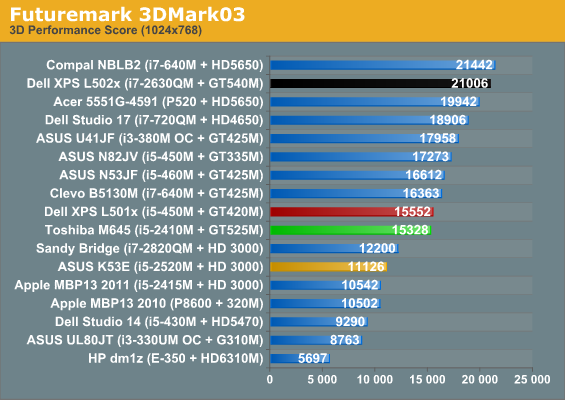
Unfortunately 3DMark is far less kind and it's here where we first see just how much damage the low clocks on the GeForce GT 525M have done. While the 96-core GPU is still a notable improvement over Intel's integrated graphics, it has a hard time hanging with even "last generation's" bottom rung 96-core chips (though in defense of "last generation," the 500M series is basically just 400M chips with a speed bump.) When we get to gaming performance, you'll see how brutally performance has been curtailed.
Gaming Performance Should Be Better
As a refresher, the NVIDIA GeForce GT 525M with 1GB of DDR3 beating at the heart of the Toshiba M645 is specced to run at 600/1200MHz on the core/shaders, but instead Toshiba runs 21% slower at just 475MHz on the core and 950MHz on the shaders. This not only puts it well below spec, it puts it below even the GeForce GT 420M. It may seem like I'm harping on this way too much, but it oftentimes means the difference between playability and stuttering. Take a look at our "low" preset scores.
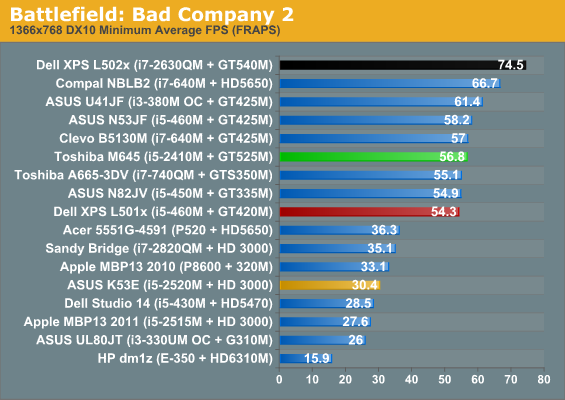
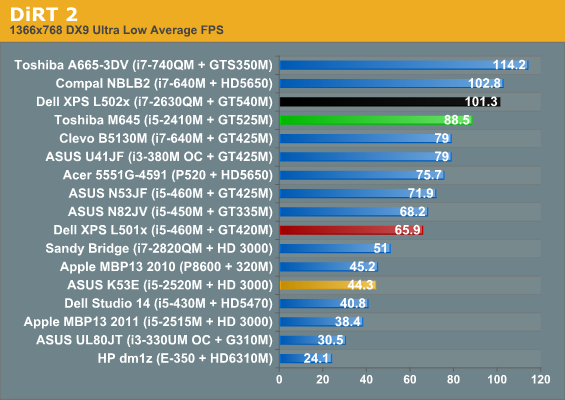
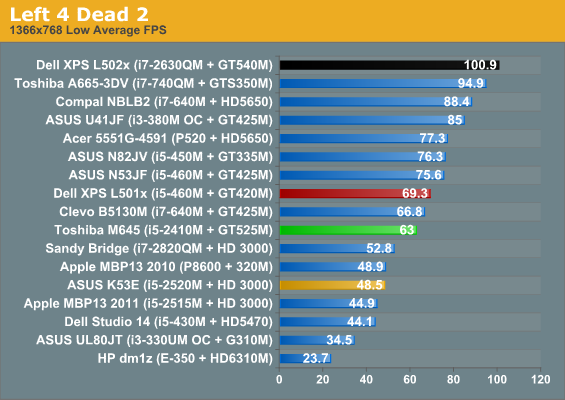
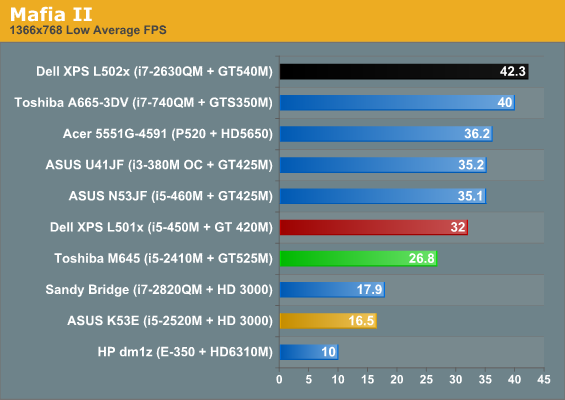
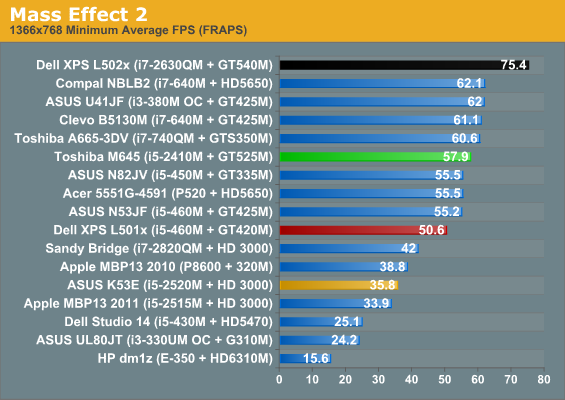
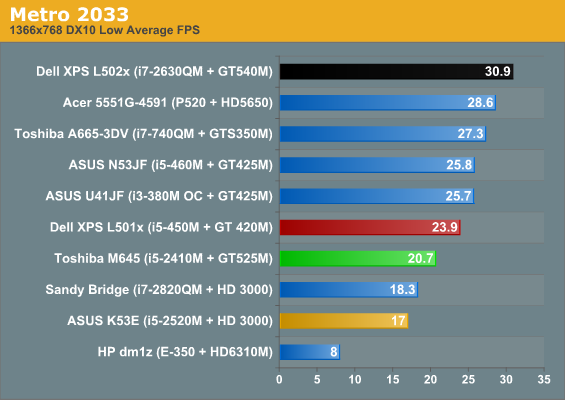
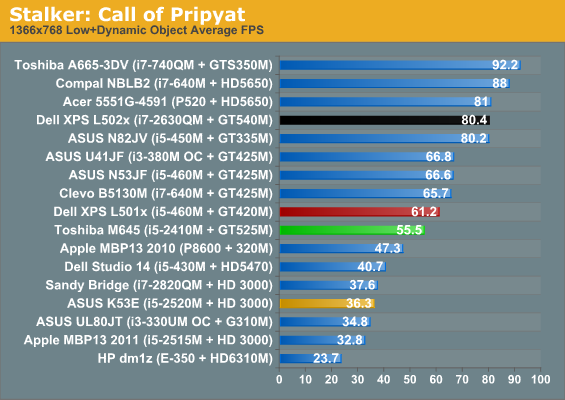
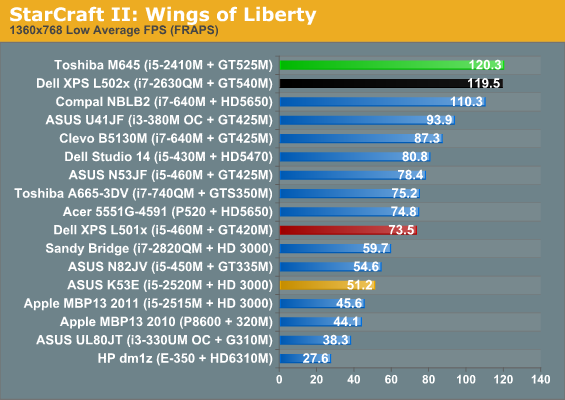
In most situations the M645 doesn't fare too bad, but at these settings there is a tendency towards being CPU-limited that allows the i5-2410M in the M645 to stretch its legs. Still, the clocks claim their first victim in Mafia II, dipping that game below the 30fps mark. We also see the L501x with a GT 420M claiming leads in Left 4 Dead 2, Mafia II, Metro 2033, and STALKER. When we bump settings up to our "medium" preset, watch the tumble the underclocked GT 525M takes.
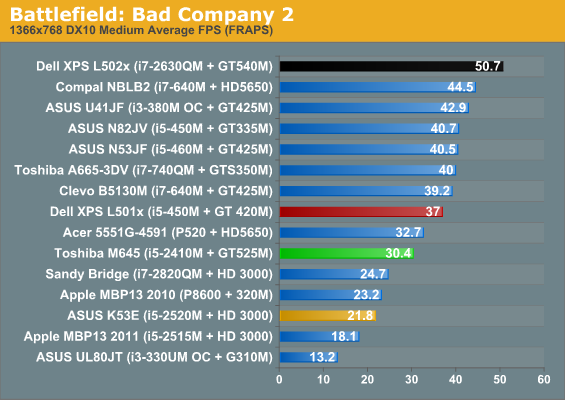
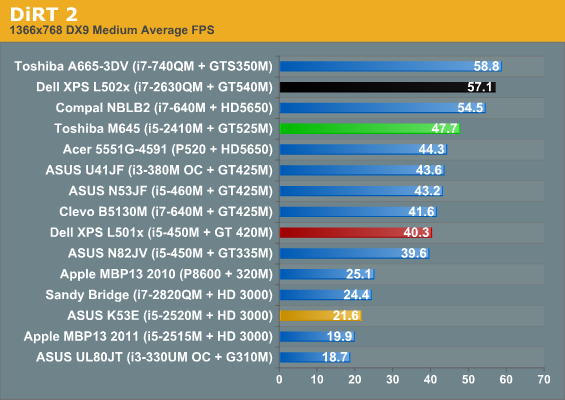
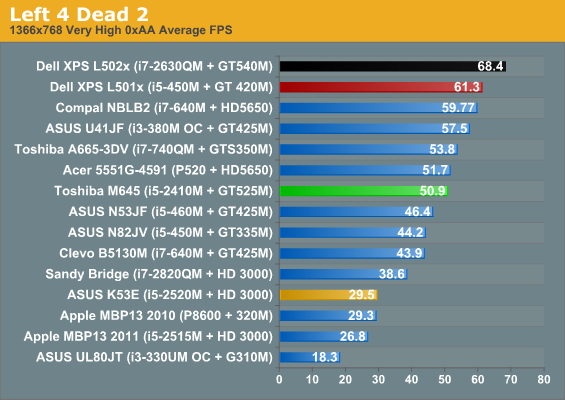
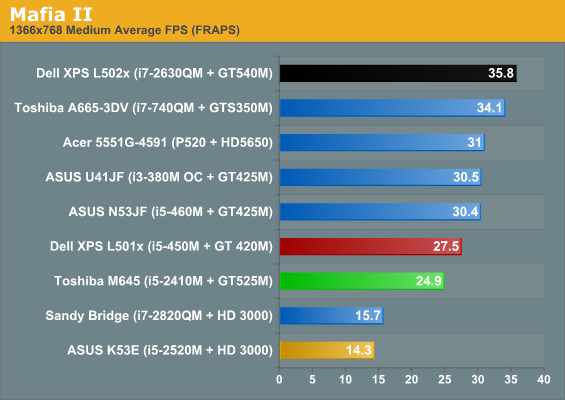
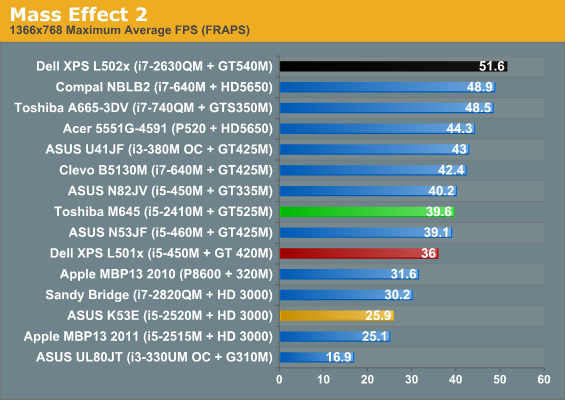
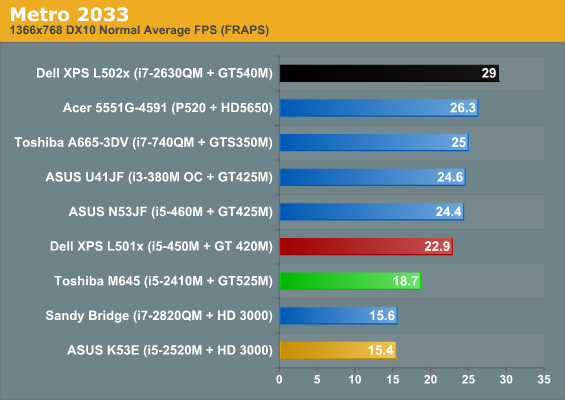
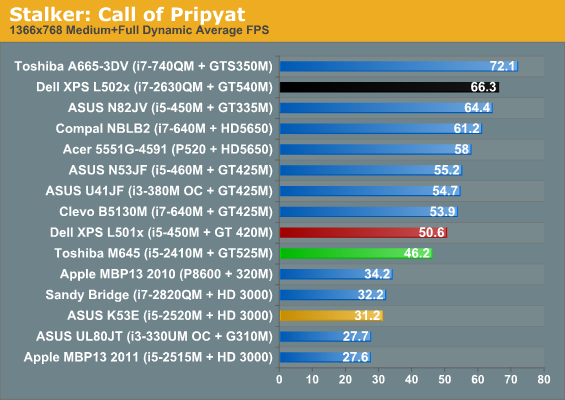
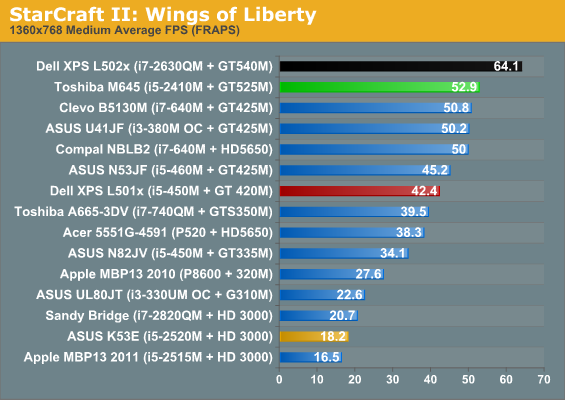
Once we get to Medium detail, the underclocked GT 525M loses ground in a hurry. Situations in more heavily GPU-limited games only get worse; any game where the M645 can't leverage its faster processor in takes a serious hit. The older L501x now leads in Battlefield: Bad Company 2, plus the other four games where it had a lead at Low settings.
Another point of reference is the GT 540M in the L502x; it should be at best about 12% faster than the GT 525M (except when the quad-core CPU in the Dell can help out, e.g. BFBC2), but the leads range from around 20% (DiRT 2 and StarCraft II) up to 55% (Metro 2033), and a maximum lead of 67% in BFBC2. The M645 still manages playable framerates in most of our test suite at medium settings, but the green bar should have been a lot closer to the black bar in the above charts.
Again we note that Left 4 Dead 2 at our medium preset requires you to set "Paged Memory Pool Available" to "Low" on Optimus systems—this appears to be a problem with the Intel HD 3000 drivers, as we had the same issue on the SNB IGP notebooks. It appears to degrade performance about 10-20%, though we can't test with the setting on "High". At over 50FPS, it's not a major concern, but the game does seem to have more HDD thrashing with this setting at Low.
The Portability Sweet Spot
The 14-inch form factor is often the best place to find a compromise between weight, performance, and price. Dipping down to 13.3" can usually get similar hardware but the price begins to creep up and often GPU performance drops; going up to 15.6-inch can get you a lower price tag but more bulk. A notebook like Toshiba's Satellite M645 can really shine if it hits the right notes in portability and performance. We know the performance is largely there and the weight isn't too bad, so how's the battery life?


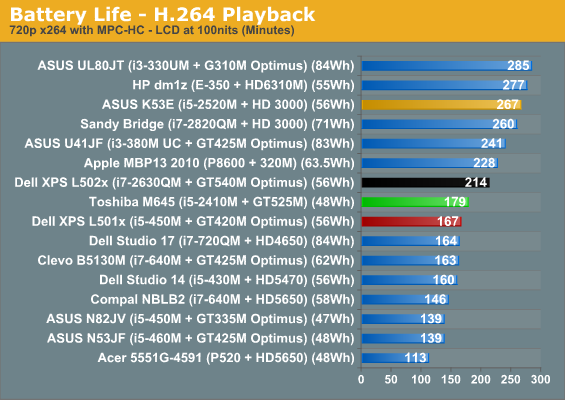
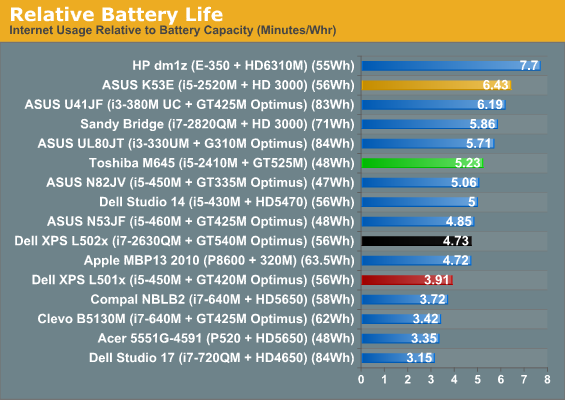
Battery life isn't great, but it's not dire either, and the M645 benefits from leveraging NVIDIA's Optimus technology. If there's a real weakness, it's in the mediocre battery the unit is saddled with; there aren't any other full-powered laptops with batteries this small that can still produce four hours of useful running time.
Heat and Noise
While typically we like to use HWMonitor to get a good look at the temperatures of the internals of our review units, in this instance even the most recent version was unable to track anything useful. The temperatures we can report put things into perspective a bit: the processor cores idled at around 46C, and under load bumped up to a still reasonable 77C. For a notebook processor, that's actually a pretty normal load temperature. The GeForce GT 525M did even better: it idled at 43C, and under load only scraped 66C. And finally, regardless of system load, the hard drive hung out at a relatively cool 38C. But it's when I look at those GPU temperatures that I start to feel a little cheated. Did Toshiba have to clock the chip down that badly? Let's see how that heat translates outside of the chassis.
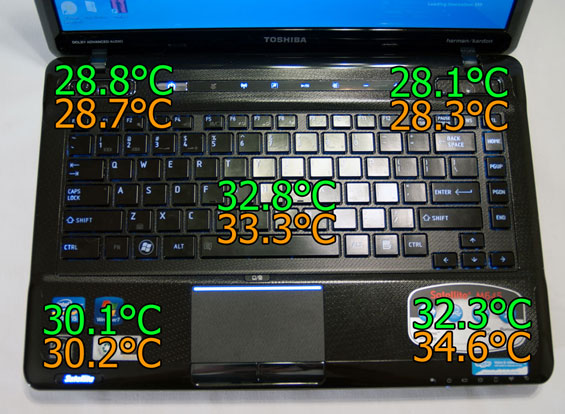
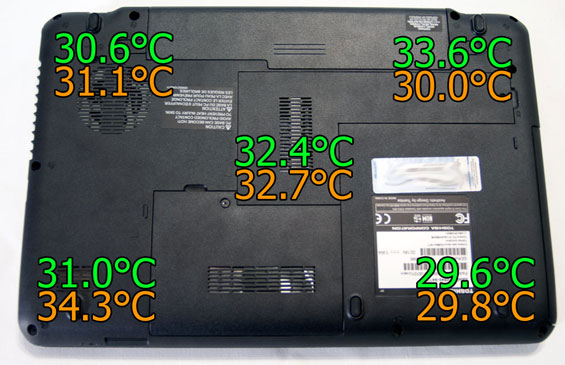
It's by no means the coolest-running notebook, but it's actually not punishingly warm either. In my admittedly anecdotal experience with overclocking mobile graphics (and NVIDIA produces some fantastic little overclockers), raising core clocks doesn't usually produce that much more heat; it's when you start ramping the RAM up that temperatures go through the roof. I don't see any reason why the GT 525M couldn't have been run at spec in the M645; there's thermal headroom here and Optimus ensures the battery life wouldn't take the hit.
As far as noise goes, the fan does whirr up under load but it's not particularly offensive. You'll hear it, but the cooling system really does a fine job of keeping everything running at reasonable temperatures while preventing the fan from producing too much noise. All told, the M645 runs cool and quiet for a 14-inch notebook.
The Curse of the TN Panel
While I do think the 1366x768 resolution is reasonable for a 14-inch screen (even if 1440x900 would be preferable), the glut of low-quality TN panels on notebooks gets tiresome. These screens only seem to get worse over time instead of better. Thankfully, while the Toshiba Satellite M645's screen isn't a huge winner, it's far from the worst screen we've tested.
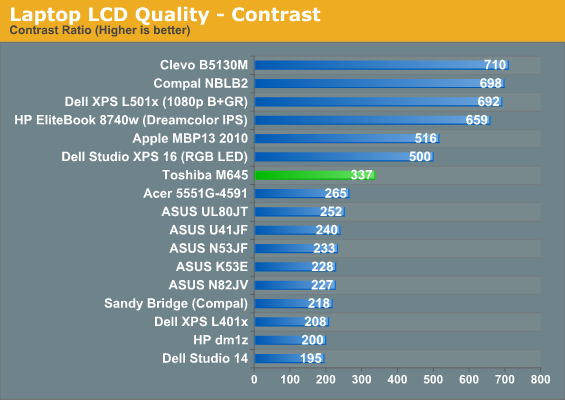
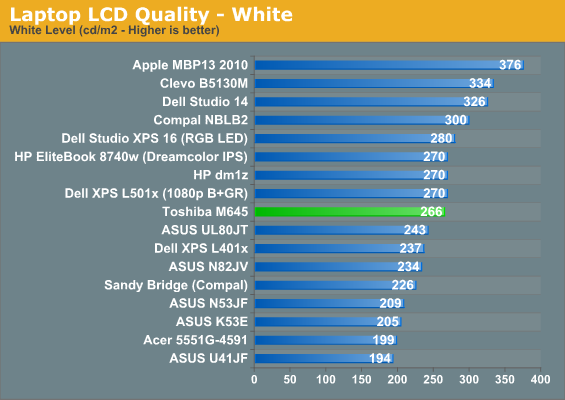
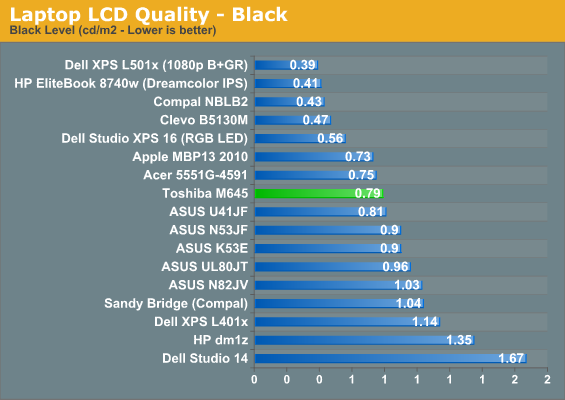

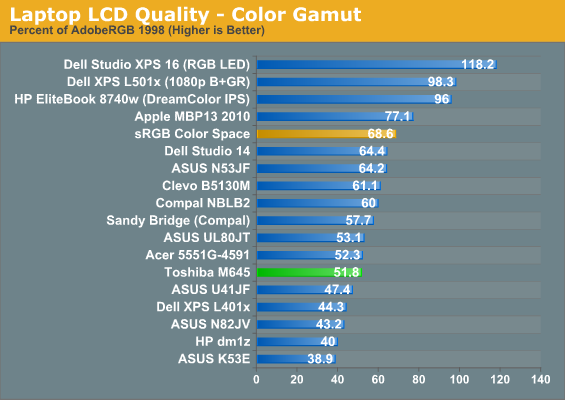
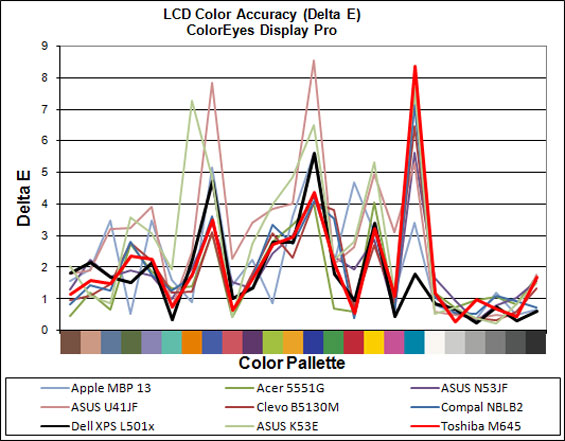
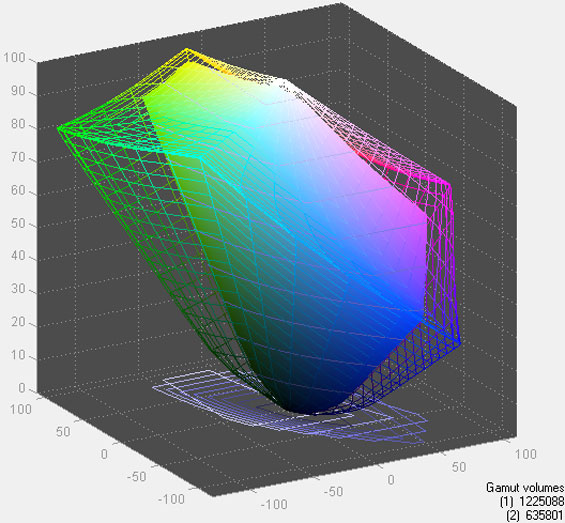
Comparatively speaking, the Toshiba M645's screen quality is above average. While TN panels remain a pox on all our houses, at least there's a halfway decent color gamut on this one, and the backlighting is nice and bright while producing good contrast. It's not going to come anywhere near the Dell L501x/L502x 1080p LCD, but it's also not as bad as the ASUS K53E.
Of course, viewing angles remain unspectacular. That's a given with TN panels and it remains true here. The problem is the things are so cheap to produce and most customers just aren't going to be that discerning. Hopefully the rise of inexpensive eIPS panels for desktop use and the slow but steady influx of IPS panels in notebooks in recent months will portend well for us; this is a persisting problem and a technology that has stagnated horribly over the past few years. It's not Toshiba's fault—it is what it is—but we can keep asking for better and hopefully at some point we'll get it.
Conclusion: Many Compromises, but Few Alternatives
I think the most frustrating thing about reviewing the Toshiba Satellite M645 was that I wanted it to succeed and instead came away thinking about what might have been. This isn't a bad notebook by any stretch of the imagination: it runs cool and quiet, has USB 3.0 connectivity, and sports switchable graphics in a 14-inch chassis. It's also a happy sign of trickle-down for Blu-ray; my Blu-ray collection has swelled since I built my media center PC, and I won't buy a notebook without a Blu-ray drive at this point. Sandy Bridge brings improved battery life and performance with it, too, and Toshiba is gradually moving away from their aggravating Fusion finish with a better keyboard and less gloss. The problem is that Toshiba compromises and makes a lot of questionable trade-offs with a rather high asking price.
Sandy Bridge notebooks may not be on the market in full force yet, but they're coming, and we're betting ASUS will be hitting all of these bulletpoints at a lower price—that's what they've historically done (at least in recent years). Having tested the Satellite M645, I'm willing to forgive the mediocre battery capacity because the notebook still puts in a decent showing in actual running time. But why, in 2011, is a notebook being released for a grand that doesn't include gigabit ethernet? Why did the GeForce GT 525M get its operating clocks hamstrung when the chassis appears to be capable of supporting the extra thermal load? Why is Toshiba continuing to saddle their notebooks with slow hard drives when machines in the same price range are offering 7200RPM drives almost as a matter of course?
Again, the M645 isn't a bad machine. At $899 it would be justifiable, and at $799 it would be a killer deal. Besides, Blu-ray combo drives for laptops aren't exactly cheap, and keyboard backlighting is a definite plus. But the $1100 MSRP is too much, and even the $1000 street price is higher than we'd like. It feels like too much of a tax for early adopters of Sandy Bridge while retailers try to clear out their remaining Arrandale stock.
The problem is that while we'd like to see the price of the M645 drop another $100, there really aren't many direct competitors. Consider what you get: a 14-inch screen chassis, keyboard backlighting, Core i5-2410M CPU, and a GeForce GT "515M"... er... underclocked GT 525M. A search of the Internet turns up very few options, and none of them are actually cheaper and clearly better than the M645. By that metric, the Toshiba M645-S4118X is a contender, albeit one with flaws. Since we mentioned alternatives, though, let's give a rundown of the options.
MSI offers a somewhat comparable notebook with their FX420: you get a Radeon HD 6470M and lose the Blu-ray combo drive, but it's available for $800. Tack on $100 for Blu-ray, and the MSI lacks the backlit keyboard (another $40) and comes with a GPU that only has 160 cores—about 30% faster than the HD 5470 in the Dell Studio 14, if you're wanting a comparison. If you don't care about games or Blu-ray, it's a reasonable laptop, but then so is the less expensive ASUS K53E.
There are two laptops we'd seriously consider in the 14-inch market. First is the Sony VAIO C series. The Sony VPCCA15FX/W also comes with the i5-2410M, a 14-inch 1366x768 LCD, USB 3.0, 500GB 5400RPM HDD, and 4GB RAM. It switches out the NVIDIA GPU for an AMD HD 6630M, which should be pretty comparable in performance, and it supports hybrid graphics. Battery life is quoted as up to 5.5 hours, which looks comparable to the M645, and you get a backlit keyboard. So the two downgrades relative to this Toshiba are the RAM (you lose 2GB) and the optical drive (no Blu-ray support), with a price that's $30 higher. Still, it's a pretty sweet looking laptop. [Ed: Sony, if you're listening, please get in touch because we'd love to do a full review.] Dell's Vostro 3450 also stacks up well against the M645, with the same CPU and and GPU as the Sony, a backlit keyboard, and 6GB RAM; you lose Blu-ray and swap the slow 640GB 5400RPM HDD for a 320GB 7200RPM drive, for a slightly lower price of $964 at the time of writing.
Alienware also has their new M14x, but that plays in a higher price (and performance) range. $1200 will net you an i7-2630QM processor and the GeForce GT 555M, though, so it will be quite a bit faster than either the Sony or Toshiba options. It also weighs about a pound more, making it a rather hefty 14-inch laptop. At that point, you might as well start considering 15.6-inch notebooks. You can grab the Dell XPS 15 L502x with its excellent speakers, beautiful 1080p LCD, 500GB 7200RPM drive, and a properly clocked GeForce GT 525M for just $950—add on Blu-ray support and keyboard backlighting and you're looking at $90 more than the M645. Or if you can stomach the keyboard (yuck), there's the 15.6-inch Acer Aspire AS5750G-9639 for just $850.
There you have it: six viable alternatives, but none of them comes off clearly superior in every category. You can get faster laptops, cheaper laptops, larger and smaller laptops; what you can't get (yet) is a 14-inch LCD, 5.4 pounds or less, decent Optimus graphics, Blu-ray, and keyboard backlighting for under $1000. Let me be honest: I like Toshiba; my first laptop was a Toshiba and it was a great computer. The M645 definitely has a place in the market, but we're still a bit put off by the corners Toshiba chose to cut and the relatively high price. Unfortunately, that's the going price for moderately powerful 14-inch laptops.


















